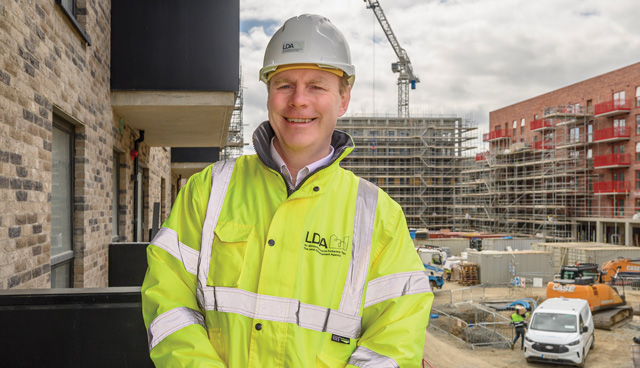
Housing Commission split on right to housing referendum
3rd July 2024
Bigger barriers to housing development than finance
3rd July 2024Coillte: Promoting wood as the sustainable building material of the future

Coillte’s Gougane Barra Forest, County Cork.
The EU aims to be climate-neutral by 2050, an objective that is at the heart of the European Green Deal and its strategy for a sustainable built environment.
Today, construction and the building sector represent 38 per cent of global energy related CO2eq emissions, and with the focus now firmly on decarbonisation, the traditional methods with which we construct our built environment are now being challenged.
In Ireland, there is an urgent need for new homes to satisfy demand, and we need to transition away from carbon intensive building materials and move to more low carbon, sustainable building solutions. Because of its significant environmental credentials, wood is now being repositioned as the sustainable building material of the future. Coillte’s forestry strategic vision aims to balance and deliver the multiple benefits of its forests for climate, nature, wood, and people.
This is a long-term vision that will see new forests created, existing forests managed for greater carbon capture, enhanced biodiversity and more recreation spaces for people to enjoy. Coillte also has an ambition to support the creation of new homes by delivering sustainably grown Irish wood products to build low-carbon houses and support the decarbonisation of the built environment.
In the period to 2030, Coillte plans to produce 25 million m3 of certified Irish wood to support the delivery of Ireland’s Climate Action Plan which seeks to cut the embodied carbon emissions for materials produced and used in Ireland by at least 30 per cent. It will also continue to promote the increased use of wood products to raise the level of homegrown wood use in the construction of housing from its current low level of 20 per cent to 80 per cent by 2050.
The drive to decarbonise can be achieved by increasing the adoption of timber frame for new homes and by unlocking the market for emerging technologies such as mass timber for medium rise residential and commercial buildings.
The fact that wood products have the lowest embodied carbon of any mainstream building materials, is now being recognised by design practitioners world-wide who are designing and building multi-storey, mass timber skyscrapers. These high-rise residential and commercial buildings are manufactured from engineered wood, off-site, in quality-controlled environments and delivered and erected on site in a matter of days. These new solutions are being rolled out across Europe but unlike our European counterparts, Ireland does not have a culture of using timber in construction and historically, our design practitioners need guidance and support to assist them to specify correctly.
We are however, beginning to see change, as the timber frame market grows, and developers begin to benefit from faster construction, less waste, and lower embodied carbon. In the coming years, we expect to see increased demand for wood and more timber frame homes. This will present significant opportunities for our forest products sector to stimulate further investment to drive sustained growth in timber processing, grown sustainably, and in the research and development of new low-carbon wood and wood-based products, components and building systems. This in turn will underpin new green jobs across the forestry supply chain and support the move to off-site modern methods of construction.
Ireland is uniquely positioned to grow the quality wood required for construction. Softwood sourced from coniferous trees such as Sitka spruce is the most popular type of wood used for construction worldwide due to its ease to work with, coupled with the fast growth rate of the trees themselves. In continental Europe a spruce tree may take up to 100 years to reach maturity, while in Ireland it can take as little as 35 years. This gives Ireland a fantastic opportunity to grow construction grade timber sustainably and quickly, creating a secure and independent homegrown supply while reducing pressure on old growth forests elsewhere in the world. Using wood in this manner drives the bioeconomy, decarbonising the construction sector with sustainability at its heart – for every tree harvested Coillte replants three trees in its place.
There is also significant interest among the development community to utilise mass timber for medium rise construction here in Ireland. However, while mass timber buildings of up to 25 stories are safely constructed in other countries, Ireland’s building regulations currently restrict the use of limited combustible materials, such as timber, to buildings of up to three storeys. The recently established Interdepartmental and Industry Timber in Construction Steering group will play a pivotal role, and with this collaborative approach, a framework can be created to work through the current barriers, allowing this form of more sustainable construction to become mainstream.
To support the increased use of timber, measures are needed to facilitate and drive the necessary innovations and technology adoptions for timber based modern methods of construction. A fast-track approach is required to develop more advanced regulations, standards and statutory guidance that allow the adoption of low carbon timber building systems whilst ensuring the highest degree of building safety. A better understanding of the benefits of building with wood is needed as well as the provision of technical guidance and support to design professionals. Focusing on training and skills development will no doubt enable a platform to support the decarbonisation of the built environment.
Timber based modern methods of construction offer a valuable solution to several issues facing housing delivery in Ireland: increasing the speed of delivery, delivering more sustainable homes, reducing the reliance for onsite labour, decarbonising our built environment, and supporting Ireland’s net zero ambitions. Other jurisdictions are already advancing their timber revolution. Ireland needs to transition to a new low carbon building model fast, for the sake of our future.

Pictured are the glulam beams used in the construction of the Seed Café at Beyond the Trees at Coillte’s Avondale Forest Park, County Wicklow.
What is mass timber?
Mass timber is a group of construction products comprising layers of timber boards bonded together to form high-performance structural beams, columns or panels, which are then used for framing, walls, floors, and roof structures.
Commonly referred to as glulam or cross laminated timber (CLT) these technologies were developed in the 1990s and are extensively used throughout Europe for medium and high-rise residential and commercial applications.
W: www.coillte.com







